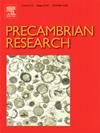Neoarchean–Paleoproterozoic magmatic–metamorphic events and its tectonic implications of the Zuoquan–Zanhuang metamorphic complexes in the North China Craton
IF 3.2
2区 地球科学
Q2 GEOSCIENCES, MULTIDISCIPLINARY
引用次数: 0
Abstract
The global felsic continental crust mostly formed during the period of early to middle Neoarchean, and most of cratons worldwide are characterized by the well-developed tectono-thermal event of ca. 2.7 Ga. Abundant geochronological data indicated that the North China Craton (NCC) was predominated by the tectono-thermal event of ca. 2.5 Ga different from many other cratons. However, isotopic studies revealed that the ca. 2.5 Ga granitoids generally formed through reworking of 2.9–2.7 Ga continental materials, and more ca. 2.7 Ga magmatic rocks and zircons have been progressively identified in some areas of the NCC in recent years. These data, therefore, prompted geologists to reconsider the importance of the ca. 2.7 Ga tectono-thermal event in the NCC. The Zuoquan and Zanhuang metamorphic complexes are adjacent and both located in central NCC. Isotopic geochronology and rare earth element analyses of zircons in this study reveals two meaningful groups of magmatic ages, i.e., 2774–2700 Ma and 2519–2496 Ma, recorded in the two complexes. The older age group predominated in the Zuoquan complex which represented an early to middle Neoarchean magmatic event and were generally interpreted to be attributed to a mantle plume or superplume mechanisms. The ages of 2519–2496 Ma were commonly recorded by rocks in the Zanhuang area, representing a regional late Neoarchean magmatic event. Two groups of metamorphic ages (2519 Ma and 1854 Ma) were also recorded by the Zuoquan and Zanhuang metamorphic rocks, respectively. The former, accompanied by the late Neoarchean magmatic event, was probably related to underplating of mantle-derived magmas. The 1854 Ma metamorphic age represented another regional metamorphism in central NCC related to a collision process between the Eastern Block and Western Block.

华北克拉通左泉—赞皇变质杂岩的新太古代—古元古代岩浆变质事件及其构造意义
全球长英质大陆地壳主要形成于新太古代早期至中期,全球大部分克拉通以约2.7 Ga发育的构造-热事件为特征。丰富的年代学资料表明,华北克拉通(NCC)不同于许多其他克拉通,以约2.5 Ga的构造-热事件为主。然而,同位素研究表明,ca. 2.5 Ga花岗岩类主要是由2.9-2.7 Ga陆相物质改造形成的,近年来在北陆块的一些地区逐渐发现了更多的ca. 2.7 Ga岩浆岩和锆石。因此,这些数据促使地质学家重新考虑NCC约2.7 Ga构造-热事件的重要性。左泉变质杂岩与赞皇变质杂岩相邻,均位于北北隆起中部。通过同位素年代学和锆石稀土元素分析,揭示了两个杂岩的岩浆年龄分别为2774 ~ 2700 Ma和2519 ~ 2496 Ma。左泉杂岩的年龄较大,代表了新太古代早期至中期的岩浆事件,一般认为是地幔柱或超地幔柱机制所致。赞皇地区岩石普遍记录2519 ~ 2496 Ma,是一个区域性的晚新太古代岩浆事件。左泉变质岩和赞黄变质岩也分别记录了2519 Ma和1854 Ma两组变质时代。前者伴随新太古代晚期岩浆活动,可能与幔源岩浆的下覆有关。1854 Ma变质期是NCC中部的又一次区域性变质作用,与东、西地块的碰撞作用有关。
本文章由计算机程序翻译,如有差异,请以英文原文为准。
求助全文
约1分钟内获得全文
求助全文
来源期刊

Precambrian Research
地学-地球科学综合
CiteScore
7.20
自引率
28.90%
发文量
325
审稿时长
12 months
期刊介绍:
Precambrian Research publishes studies on all aspects of the early stages of the composition, structure and evolution of the Earth and its planetary neighbours. With a focus on process-oriented and comparative studies, it covers, but is not restricted to, subjects such as:
(1) Chemical, biological, biochemical and cosmochemical evolution; the origin of life; the evolution of the oceans and atmosphere; the early fossil record; palaeobiology;
(2) Geochronology and isotope and elemental geochemistry;
(3) Precambrian mineral deposits;
(4) Geophysical aspects of the early Earth and Precambrian terrains;
(5) Nature, formation and evolution of the Precambrian lithosphere and mantle including magmatic, depositional, metamorphic and tectonic processes.
In addition, the editors particularly welcome integrated process-oriented studies that involve a combination of the above fields and comparative studies that demonstrate the effect of Precambrian evolution on Phanerozoic earth system processes.
Regional and localised studies of Precambrian phenomena are considered appropriate only when the detail and quality allow illustration of a wider process, or when significant gaps in basic knowledge of a particular area can be filled.
 求助内容:
求助内容: 应助结果提醒方式:
应助结果提醒方式:


